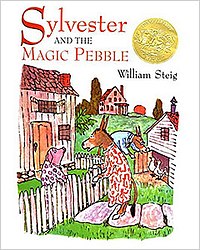Lowell, Susan. 1992. THE THREE LITTLE JAVELINAS. Ill. by Jim Harris. Flagstaff, AZ: Rising Moon. ISBN 0873585429
2. PLOT SUMMARY
This story takes the original tale of the three little pigs and adds a southwestern twist. The three little javelinas live in the desert and have set out to make homes of their own. The first javelina builds his home from tumbleweeds. A conniving coyote stumbles upon this house and causes the tumbleweed home to collapse when he huffs and puffs. The first little javelina escapes to the home of the second little javelina who has built his home from saguaro ribs. Once again the coyote finds the javelinas and also destroys this home.
Finally, the two javelinas meet with the third javelina who has built her home from adobe bricks. When the coyote tries to huff and puff, the adobe home is strong enough to withstand the attack. The clever coyote tries once more to enter the adobe home through the stove pipe, but the javelinas think quickly and light a fire in the stove, sending the coyote running through the desert howling in pain.
3. CRITICAL ANALYSIS
Lowell's use of an action packed plot keeps this story fresh even though it is a timeless tale. The conflict caused by the coyote repeatedly plotting disaster keeps the plot moving at a fast pace. The southwestern setting also contributes to a new take on this old favorite. The javelinas' use of tumbleweeds, saguaro ribs, and adobe bricks highlights their ingenuity and resourcefulness in a dry and deserted region. Lowell's writing style seamlessly incorporates these changes while closely aligning with the plot of the original tale. Vivid diction such as "the first little javelina wandered lazily along" or "the three little javelinas trotted away to seek their fortune" helps convey a sense of a slower paced life in the desert. Lowell's style also helps to highlight the setting by using local dialect in phrases such as "...'Ha'u' which means 'yes' in the language of the Desert People."
This tale emphasizes the theme of good versus evil because the three little javelinas eventually triumph over the big, bad coyote. Lowell, adds a humorous twist to this familiar theme by informing the reader that "if you ever hear Coyote's voice, way out in the desert at night...well, you know what he's remembering!" Lowell uses this line to refer to the eventual demise of the coyote when the javelinas light the stove pipe and send the coyote away howling in a puff of smoke.
Jim Harris uses vivid colors to make even the desert an appealing setting. The illustrations accurately portray text descriptions such as "steep purple mountains looked down on the desert where the cactus forests grew." Splashes of color may be seen in the javelinas' clothing, the wildflowers, or the flowering buds of the cactus. The adjacent placement of text on one page and full page illustrations on the opposite page make for an easy read. Smaller key illustrations found on the same page as the text serve to complement and extend the full page illustrations. For example, the full page illustration of the tumbleweed home is complemented by a small image of the whirlwind that gave the first javelina the idea to construct his home from tumbleweeds.
The illustrations enhance the cultural image created by the text by offering accurate visuals of natural resources, vegetation, animal life, and people found in the desert. Harris' illustrations of the Native American woman and the Spanish speaking brick maker help readers to experience life in the desert of the southwest. One image of a hot javelina sweating profusely in the sweltering desert sun allows the reader to experience the intense heat of the region.
4. PERSONAL RESPONSE: STRENGTHS AND WEAKNESSES
This comical twist on the original version proves to be a notable strength of this book. Especially entertaining are the jokes related to the hairy nature of the javelinas. For example, Lowell states that "their heads were hairy, their backs were hairy, and their bony legs-all the way down to their hard little hooves-were very hairy." The use of inventive building materials to construct the javelinas' homes serves to educate readers on the local climate and natural resources of the Southwest. A possible weakness of this book might be the use of specialized language related to the Southwest. English language learners unfamiliar with terms such as saguaros ribs, javelina, and adobe may need extra assistance to fully understand their meanings. However, explaining these terms will be beneficial to all students, even those that are not English language learners.
5. REVIEW EXCERPT(S)
"In her first book for children, Lowell spices the story with elements of Native American, Mexican and Old West culture." (PUBLISHERS WEEKLY)
"Complete harmony of text and pictures: altogether lovely." (KIRKUS REVIEWS)
"Whether read aloud or in amused solitude, this is a picture book that will be enjoyed again and again." (SCHOOL LIBRARY JOURNAL)
6. CONNECTIONS
*Students can select a geographic region, research resources, and tools available in that area for building, and write their own version of THE THREE LITTLE PIGS in their unique setting of choice.
*Students can construct models of the three types of homes created by the javelinas using resources around the home (toothpicks, clay, sticks).
*Students can research the desert climate and share information on animals, plants, and weather patterns related to that region.



